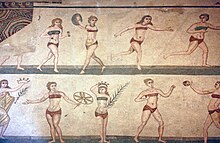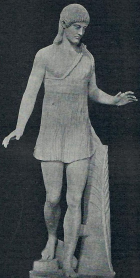
A | B | C | D | E | F | G | H | CH | I | J | K | L | M | N | O | P | Q | R | S | T | U | V | W | X | Y | Z | 0 | 1 | 2 | 3 | 4 | 5 | 6 | 7 | 8 | 9
This article has multiple issues. Please help improve it or discuss these issues on the talk page. (Learn how and when to remove these template messages)
|
| Part of a series on |
| Women in society |
|---|
 |
The participation of women and girls in sports, physical fitness, and exercise has been recorded to have existed throughout history. However, participation rates and activities vary in accordance with nation, era, geography, and stage of economic development. While initially occurring informally, the modern era of organized sports did not begin to emerge either for women or men until the late industrial age.
Until roughly 1870, women's activities tended to be informal and recreational in nature, lacked rules codes, and emphasized physical activity rather than competition.[1] Today, women's sports are more sport-specific and have developed into both amateur levels and professional levels in various places internationally, but is found primarily within developed countries where conscious organization and accumulation of wealth has occurred. In the mid-to-latter part of the 20th century, female participation in sport and the popularization of their involvement increased, particularly during its last quarter. Very few organized sports have been invented by women. Sports such as Newcomb ball, netball, acrobatic gymnastics, and tumbling,[2] and possibly stoolball, are examples. More recent examples include Pamela Frey's sport of BasKua in Argentina,[3][4][5] and the game of Crokicurl by Liz Wreford and Leanne Muir in Canada.
Women's involvement in sports is more visible in well-developed countries and today their level of participation and performance still varies greatly by country and by sport. Despite an increase in women's participation in sport, the male demographic is still the larger of the two.[1] These demographic differences are observed globally. Female dominated sports are the one exception. Girls' participation in sports tend to be higher in the United States than in other parts of the world like Western Europe and Latin America.[6] Girls' participation in more violent contact sports is far less than that of their male counterparts.

Two important divisions exist in relation to female sporting categories. These sports either emerged exclusively as an organized female sport or were developed as an organized female variant of a sport first popularized by a male demographic and therefore became a female category. In all but a few exceptional cases, such as in the case of camogie, a female variant, or "women's game" uses the same name of the sport popularly played by men, but is classified into a different category which is differentiated by sex: men's or women's, or girls or boys. Female variants are widely common while organized female sports by comparison are rare and include team sports such as netball, throwball, artistic (née synchronized) swimming,[7] and ringette. In female sports, the supposed benefits of gender parity,[8] gender equity, and gender equality feminism are controversial.
Except in a few rare cases like women's professional tennis, professional women's sport rarely provide competitors with a livable income. In addition, competing for media coverage of the women's variant of a sport which is primarily popular among males, creates complex barriers. More recently, there has been an increasing amount of interest, research, investment and production in regards to equipment design for female athletes. Interest and research involving the identification of sex-specific injuries, particularly though not exclusively among high performance female athletes, has increased as well, such as in the case of concussions[9][10][11] and the female athlete triad, a.k.a. "Relative energy deficiency in sport" (RED-S).[12][13]
At times female athletes have engaged in social activism in conjunction with their participation in sport. Protest methods have included playing strikes, social media campaigns, and in the case of America, federal lawsuits on grounds of inequality, usually as it relates to gender parity principles, American law and Title IX which demand schools that any funds given to support students' sports should be equally distributed between boys and girls. Public service oriented promotional campaigns for girls in sport involve a variety of media campaign styles.[14]
History
Ancient civilizations


Before each ancient Olympic Games a separate women's athletic event was held at the stadium in Olympia, called the Heraean Games and was dedicated to the goddess Hera. In ancient Greek mythology there was the belief that Heraea was founded by Hippodameia, the wife of the king who founded the Olympics.[15] According to E. Norman Gardiner:
At the festival there were races for maidens of various ages. Their course was 500 feet, or one-sixth less than the men's stadium. The maidens ran with their hair down their backs, a short tunic reaching just below the knee, and their right shoulder bare to the breast. The victors received crowns of olive and a share of the heifer sacrificed to Hera. They had, too, the right of setting up their statues in the Heraeum.[16]
Although married women were excluded from the Olympics even as spectators, Cynisca won an Olympic game as owner of a chariot (champions of chariot races were owners not riders), as did Euryleonis, Belistiche, Zeuxo, Encrateia and Hermione, Timarete, Theodota and Kassia.
After the classical period, there was some participation by women in men's athletic festivals.[15] Women in Sparta began to practice the same athletic exercises that men did, exhibiting the qualities of Spartan soldiers. Plato even supported women in sports by advocating running and sword-fighting for women.[17]
Notably, cultural representations of a pronounced female physicality were not limited to sport in Ancient Greece and can also be found in representations of a group of warrioresses known as the Amazons.
In Book Six of the Odyssey, Nausicaa and her handmaidens engage in light sport as they're waiting for the clothes they've washed to dry ...
- Then they bathed, and gave
- Their limbs the delicate oil, and took their meal Zdroj:https://en.wikipedia.org?pojem=Women's_rights_in_sports
Text je dostupný za podmienok Creative Commons Attribution/Share-Alike License 3.0 Unported; prípadne za ďalších podmienok. Podrobnejšie informácie nájdete na stránke Podmienky použitia.
Antropológia
Aplikované vedy
Bibliometria
Dejiny vedy
Encyklopédie
Filozofia vedy
Forenzné vedy
Humanitné vedy
Knižničná veda
Kryogenika
Kryptológia
Kulturológia
Literárna veda
Medzidisciplinárne oblasti
Metódy kvantitatívnej analýzy
Metavedy
Metodika
Text je dostupný za podmienok Creative
Commons Attribution/Share-Alike License 3.0 Unported; prípadne za ďalších
podmienok.
Podrobnejšie informácie nájdete na stránke Podmienky
použitia.
www.astronomia.sk | www.biologia.sk | www.botanika.sk | www.dejiny.sk | www.economy.sk | www.elektrotechnika.sk | www.estetika.sk | www.farmakologia.sk | www.filozofia.sk | Fyzika | www.futurologia.sk | www.genetika.sk | www.chemia.sk | www.lingvistika.sk | www.politologia.sk | www.psychologia.sk | www.sexuologia.sk | www.sociologia.sk | www.veda.sk I www.zoologia.sk




